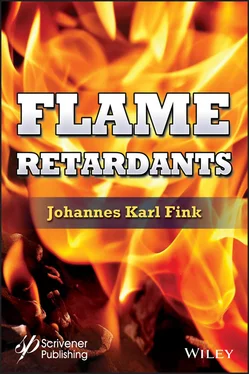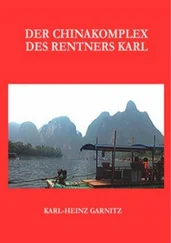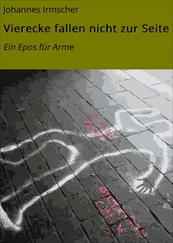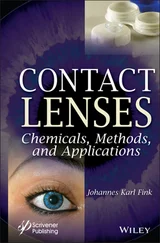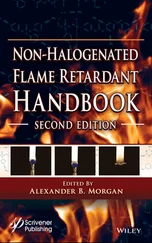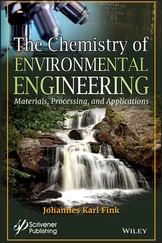Library of Congress Cataloging-in-Publication Data
ISBN 978-1-119-75061-1
Cover image: Pixabay.ComCover design by Russell Richardson
This book focuses on the chemistry and applications of flame retardants for polymers and other materials. The text focuses mainly on the literature of the last decade.
The book starts with a description of flame retardants. Here various types of flame retardants, their properties, and their chemical structures are detailed. These include chlorine- and bromine-containing flame retardants, phosphorus-based flame retardants, nitrogen-based flame retardants, and silicones. Inorganic materials that serve as flame retardants, such as boron-based additives, graphenes and others, are also discussed. Here, in general, the activity of such flame retardants is also illustrated and the flame retardant effect, mostly on polymers, is illustrated. However, flame retardant polymers as such are discussed in a separate chapter.
In the next chapter, the mechanisms of flame retardants are discussed, such as flame cooling, synergetic effects, degradation of flame retardants, and others.
Besides flame retardants, other compounds are of interest in flame retardant compositions, such as dripping inhibitors and smoke suppressants. These compounds are detailed in two separate chapters. In addition, testing methods for flame retardants and available international standards are of importance. These issues, together with human health hazards, such as smoke toxicity and problems with wastes, are discussed in another chapter.
In still another chapter, synthesis and fabrication methods, as well as recycling methods, are discussed. Besides common chemical synthesis methods, some unconventional methods are available, such as mechano-chemical methods. Also, the application of flame retardants to the final material is of interest. This can be done using 3D printing, reactive coating, or bulk addition methods.
As mentioned at the beginning, flame retardant polymers as such are discussed in a separate chapter, i.e., Examples of Polymers . Besides commonly known flame retardant materials, such as PVC, Teflon, etc., a lot of polymers can be made flame retardant by including non-burning comonomers. Also, issues concerning foams, nanocomposites, and bio-based material are discussed.
The final chapter deals with special uses of flame retardants. These include textiles, wool, and electrical applications such as batteries.
So, a lot of interesting points of view are presented that might be of interest to various professionals in, for example, the car, aircraft and electric industries. So, beyond education, this book will serve the needs of industry engineers and specialists who have only a passing knowledge of the plastics and composites industries but need to know more.
Utmost care has been taken to present reliable data. Because of the vast variety of material presented here, however, the text cannot be complete in all aspects, and it is recommended that the reader study the original literature for more complete information.
The reader should be aware that mostly US patents have been cited where available, but not the corresponding equivalent patents in other countries. For this reason, the author cannot assume responsibility for the completeness, validity or consequences of the use of the material presented herein. Every attempt has been made to identify trademarks; however, there were some that the author was unable to locate.
There are three indices: an index of acronyms, an index of chemicals, and a general index.
In the index of chemicals, compounds that occur extensively, e.g., “acetone,” are not included at every occurrence, but rather when they appear in an important context.
I am indebted to our university librarians, Dr. Christian Hasenhüttl, Margit Keshmiri, Friedrich Scheer, Christian Slamenik, Renate Tschabuschnig, and Elisabeth Groß for support in literature acquisition. I also want to express my gratitude to all the scientists who have carefully published their results concerning the topics dealt with herein. This book could not have been otherwise compiled.
Last, but not least, I want to thank the publisher, Martin Scrivener, for his abiding interest and help in the preparation of the text. In addition, my thanks go to Jean Markovic, who made the final copyedit with utmost care.
Johannes FinkLeoben, May 6, 2020
Конец ознакомительного фрагмента.
Текст предоставлен ООО «ЛитРес».
Прочитайте эту книгу целиком, на ЛитРес.
Безопасно оплатить книгу можно банковской картой Visa, MasterCard, Maestro, со счета мобильного телефона, с платежного терминала, в салоне МТС или Связной, через PayPal, WebMoney, Яндекс.Деньги, QIWI Кошелек, бонусными картами или другим удобным Вам способом.
